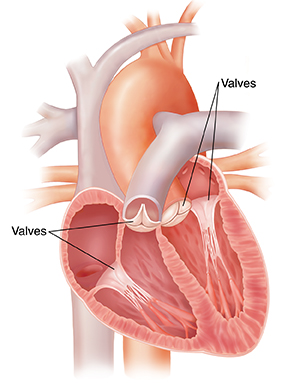Understanding Infective Endocarditis
Infective endocarditis is an infection of the lining of the heart (endocardium) or the valves of the heart. The infection is most often from some type of bacteria. But other germs, such as fungi, can also cause it. Viruses are not known to cause endocarditis.

How does infective endocarditis cause problems?
Infective endocarditis starts when bacteria or another type of germ is introduced into the bloodstream. As the bacteria circulate in the bloodstream, structures within the heart are exposed. There are 4 valves in your heart. These valves keep blood flowing through the heart in the right direction. Bacteria have a tendency to attach to these valves or their surrounding support structure and cause damage. This may lead to valve failure and heart failure. Furthermore, as the bacteria continue to grow within the heart, they may become large enough to form clumps of bacteria called vegetations. These serve as a reservoir of bacteria and can continue to release bacteria into the bloodstream. Sometimes these vegetations may break off and travel to another part of the body. This can block blood flow and seed another body part with bacteria.
What causes infective endocarditis?
Bacteria normally live on and in your body. For example, they live on your skin or in your mouth. But sometimes the bacteria can get into your bloodstream. This can happen after a medical or dental test or procedure. The bacteria may travel to your heart. They may settle in the lining of the heart or on the valves. This occurs more often in people who have certain heart or heart valve problems. It rarely occurs in people who don't have heart problems.
You are more likely to be at risk for infective endocarditis if you have or had any of these:
-
Heart defects, such as those present at birth (congenital)
-
Valve disease, such as mitral valve prolapse
-
Damage to the heart valves from an infection (rheumatic heart disease)
-
Surgery to replace a damaged heart valve
-
Artificial heart valves (prosthetic valves) and indwelling cardiac devices, such as pacemakers
-
History of endocarditis
-
Recreational I.V. (intravenous) drug use
-
Problems with teeth, poor condition of teeth, or mouth infections
-
Hemodialysis for kidney failure
-
Catheter in a vein (IV) or blood vessel (intravascular) for a medical procedure
-
Weak immune system due to HIV or chemotherapy, for example
-
Diabetes mellitus
Symptoms of infective endocarditis
The infection can start suddenly with severe symptoms (acute endocarditis). Or it can start more slowly and be less severe (subacute endocarditis). Symptoms may include:
-
Flu-like symptoms, such as fever, chills, night sweats, tiredness, muscle and joint aches, and headache.
-
Chronic fatigue.
-
Weight loss.
-
Loss of appetite.
-
Trouble breathing.
-
Decreased exercise tolerance.
-
Joint pain (arthralgia) and muscle pain (myalgia).
-
Rapid heartbeat.
-
Cough.
-
Nausea and vomiting.
-
Skin changes, such as paleness, and sores on the fingers or toes.
-
Tiny red spots on the skin, under the fingernails, in the whites of the eyes, and inside the mouth.
-
Blood in the urine.
-
Swelling of the feet, legs, or belly (abdomen).
-
A fever of 100.4°F (38°C) or higher.
Diagnosing infective endocarditis
Your health care provider will review your symptoms and your health history. They will give you a physical exam. They will listen to your heart and may hear an abnormal sound (heart murmur). You may also have tests, such as:
-
Blood or urine cultures. This test checks for infection in samples of blood or urine.
-
Other blood tests. Many other blood tests may be done. For example, you may have a complete blood count.
-
Echocardiography. This test uses ultrasound waves to see your heart valves and blood moving through your heart. This can be done by either:
-
Electrocardiography. This test checks your heart rhythm.
-
Chest X-ray. This is done to look for problems in your lungs.
-
Cardiac CT scan. This test uses X-rays to make a detailed image of your heart.
Online Medical Reviewer:
Robyn Zercher FNP
Online Medical Reviewer:
Steven Kang MD
Online Medical Reviewer:
Vinita Wadhawan Researcher
Date Last Reviewed:
3/1/2025
© 2000-2025 The StayWell Company, LLC. All rights reserved. This information is not intended as a substitute for professional medical care. Always follow your healthcare professional's instructions.